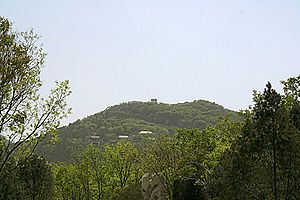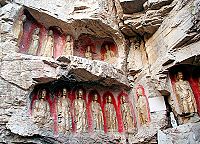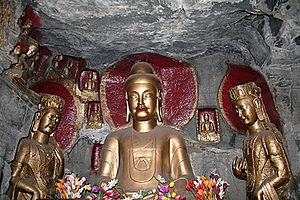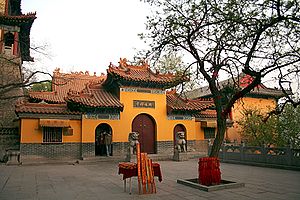
Thousand Buddha Mountain
Encyclopedia
The Thousand Buddha Mountain is a hill located southeast of the city of Jinan
, the capital of Shandong
Province, China
. It is renowned for its numerous Buddha
images which have been carved out of the hill's rock faces or free-standing structures erect since the times of the Sui Dynasty
(581-618) and its Xingguochan Temple.
 The Thousand Buddha Mountain is a small hill located about 2.5 kilometres southeast from the center of the city of Jinan 济南. The hill's ridge runs in east-west direction and the summit rises 285 metres above sea level and
The Thousand Buddha Mountain is a small hill located about 2.5 kilometres southeast from the center of the city of Jinan 济南. The hill's ridge runs in east-west direction and the summit rises 285 metres above sea level and
slightly more than 200 metres from the hill's base. Since 1959, it has been a public park which also comprises Yellowstone Cliff (Huangshi Ya 黄石崖) to the south and Jueshan Mountain to the east and covers a total area of 1.66 square kilometers.
The Thousand Buddha Mountain Public Park is flanked by a cemetery honoring the fallen of the Xinhai Revolution
of 1911 on the east side, the Shandong Provincial Museum to the northeast, and the Jinan Botanical Garden on the west side.
 According to a legend related in the Youyang Zazu (Youyang Miscellanies) by the Tang Dynasty
According to a legend related in the Youyang Zazu (Youyang Miscellanies) by the Tang Dynasty
writer Duan Chengshi
(800-863), the Thousand Buddha Mountain was originally located by the sea and the sea god had locked it in place there by a large lock in order to prevent the god in charge of the mountains from moving it around. However, eventually the lock broke and the mountain was hurled through the air into its present position. An artwork shaped as a large lock and a piece of chain has been placed on the summit of the mountain as a reference to the legend.
 Buddhism became popular in the Jinan area during the reign of
Buddhism became popular in the Jinan area during the reign of
Emperor Wen
, the founder of the Sui Dynasty
. With Buddhism, monks came to area and chiseled Buddha statues out of the flanks of the hill, which was originally called Miji Hill or Li Hill. A temple, called the Thousand Buddha Temple (Qianfosi) was founded at the foot of the hill. Eventually, the hill was renamed after the temple into "Thousand Buddha Mountain". One of the old names, Li Hill (Li Shan), survives in the name of Lishan Road, the major avenue which runs through Jinan towards the Thousand Buddha Mountain in north-south direction.
 The Thousand-Buddha Cliff
The Thousand-Buddha Cliff
is located on the northern flank of the hill behind the Xingguochan Temple (s. below). The foot of the cliff is pierced by five caves, which are named (from west to east): Longquan (Dragon Spring) Cave, Jile (Extremely Happy) Cave, Qianlou (probably a person's name) Cave, and Luzhu (probably a person's name) Cave. The caves' height ranges from 3 meters down to only 20 centimeters. About 130 Buddha statues which were carved into Thousand-Buddha Cliff during the Sui period remain today. The Jile Cave houses 16 Buddha statues, the tallest of which is 3 m high.
 Along with the Buddha statues, temples and other buildings were erected on the hill. The most renown of these structures is the Xingguochan Temple which was originally build during the reign of Emperor Taizhong
Along with the Buddha statues, temples and other buildings were erected on the hill. The most renown of these structures is the Xingguochan Temple which was originally build during the reign of Emperor Taizhong
of Tang
as an expansion of the Sui-Dynasty Qianfo Temple. Further enlargements were undertaken during the Song Dynasty
, but the temple was destroyed by war afterwards. Rebuilding was undertaken in 1468, during the Ming Dynasty
. The Guanying Hall, the Foye Hall, and the Thousand-Hands Buddha statue were added during the Qing Dynasty
.
 The temple is located about half-way up the hill and can be reached via 300 stone steps. A large inscription (total area about 15 square meters) cut into the cliff face to the southwest of the identifies it as the "Number One Temple" (Di Yi Mi Hua). The temple's courtyards feature several stone tablets bearing inscriptions from renown calligraphers. In one of the temple's courtyards stands a sculpture of the legendary Emperor Shun, who is—according to the local tradition—credited with first ploughing the soil in Jinan as well as with inventing the writing brush. Because of its mythological association with Emperor Shun, the Thousand Buddha hill is also known as Shungeng Hill. The main structure of the temple are: Grand Prayer Hall, Guanying Hall, Dharma
The temple is located about half-way up the hill and can be reached via 300 stone steps. A large inscription (total area about 15 square meters) cut into the cliff face to the southwest of the identifies it as the "Number One Temple" (Di Yi Mi Hua). The temple's courtyards feature several stone tablets bearing inscriptions from renown calligraphers. In one of the temple's courtyards stands a sculpture of the legendary Emperor Shun, who is—according to the local tradition—credited with first ploughing the soil in Jinan as well as with inventing the writing brush. Because of its mythological association with Emperor Shun, the Thousand Buddha hill is also known as Shungeng Hill. The main structure of the temple are: Grand Prayer Hall, Guanying Hall, Dharma
Hall, Maitreya
Hall, and the Buddhist Scripture building. Lishanyuan courtyard, to the east of the temple, is surrounded by sites of worship belonging to Confucianism
, Taoism
, and Buddhism. The names of these buildings are: the Shun and the Luban Ancestral Temples, the Wenchang ("Develop the Culture") Cabinet, and the Yilan Kiosk. The temple has been the site of two annual temple fairs held on the 3rd day of the third month and 9th day of the 9th month of the Chinese Lunar Calendar
since the times of the Yuan Dynasty
. It was burned down in wars and rebuild during the Ming Dynasty
. Other notable buildings on the hill are: the Pagoda Tree Pavilion (Tang Dynasty), Cloud Passing Zen Temple, and the Tanghuai Kiosk.
Many of the statues on the Thousand Buddha Mountain were damaged or lost during the Cultural Revolution
, but restoration started in 1979 already. Since then, many new statues have been added. The largest largest new statues are a 20 meter-tall sitting Maitreya Buddha completed in 2000 and lying Buddha with a swastika
on his chest. The latter statue was carved out of granite
in 1996, has a length of 10 meters and weighs approximately 50 tonnes.
The Thousand Buddha Mountain Public Park has been developed extensively for—mostly local tourism—by the creation of access roads and walking paths as well the addition of amusement park
features such as a 600 meter-long chairlift
, a summer slide (the "Qineng Slide") down the hill, a kart racing
track, and numerous souvenir stalls (one of which was placed right at the summit as of 2006). A major tourist attraction is the Myriad Buddha Cave (Wanfo Dong) at the foot of the hill's northern slope. Inside the more than 500 meter-long artificial cave, late-20th-century recreations of Buddhist statues from four famous Chinese grottoes (Dunhuang
and Maiji Shan in Gansu
Province, Longmen
in Henan
Province, Yun Gang in Shanxi
Province) are on display. The original artworks were created during the Northern Wei, Tang
, and Song
dynasties. According to the operators (information provided on the backside of the entrance ticket as of 2006), around 28 000 Buddhist images are on display inside the cave, the biggest statue—a lying Buddha—is 28 meters long.
Jinan
Jinan is the capital of Shandong province in Eastern China. The area of present-day Jinan has played an important role in the history of the region from the earliest beginnings of civilisation and has evolved into a major national administrative, economic, and transportation hub...
, the capital of Shandong
Shandong
' is a Province located on the eastern coast of the People's Republic of China. Shandong has played a major role in Chinese history from the beginning of Chinese civilization along the lower reaches of the Yellow River and served as a pivotal cultural and religious site for Taoism, Chinese...
Province, China
China
Chinese civilization may refer to:* China for more general discussion of the country.* Chinese culture* Greater China, the transnational community of ethnic Chinese.* History of China* Sinosphere, the area historically affected by Chinese culture...
. It is renowned for its numerous Buddha
Gautama Buddha
Siddhārtha Gautama was a spiritual teacher from the Indian subcontinent, on whose teachings Buddhism was founded. In most Buddhist traditions, he is regarded as the Supreme Buddha Siddhārtha Gautama (Sanskrit: सिद्धार्थ गौतम; Pali: Siddhattha Gotama) was a spiritual teacher from the Indian...
images which have been carved out of the hill's rock faces or free-standing structures erect since the times of the Sui Dynasty
Sui Dynasty
The Sui Dynasty was a powerful, but short-lived Imperial Chinese dynasty. Preceded by the Southern and Northern Dynasties, it ended nearly four centuries of division between rival regimes. It was followed by the Tang Dynasty....
(581-618) and its Xingguochan Temple.
Location

slightly more than 200 metres from the hill's base. Since 1959, it has been a public park which also comprises Yellowstone Cliff (Huangshi Ya 黄石崖) to the south and Jueshan Mountain to the east and covers a total area of 1.66 square kilometers.
The Thousand Buddha Mountain Public Park is flanked by a cemetery honoring the fallen of the Xinhai Revolution
Xinhai Revolution
The Xinhai Revolution or Hsinhai Revolution, also known as Revolution of 1911 or the Chinese Revolution, was a revolution that overthrew China's last imperial dynasty, the Qing , and established the Republic of China...
of 1911 on the east side, the Shandong Provincial Museum to the northeast, and the Jinan Botanical Garden on the west side.
Legend

Tang Dynasty
The Tang Dynasty was an imperial dynasty of China preceded by the Sui Dynasty and followed by the Five Dynasties and Ten Kingdoms Period. It was founded by the Li family, who seized power during the decline and collapse of the Sui Empire...
writer Duan Chengshi
Duan Chengshi
Duan Chengshi was an author and scholar of the Tang Dynasty in China. He was born to a wealthy family in present day Zibo, Shandong. A descendant of the early Tang official Duan Zhixuan 段志玄 , and the son of Duan Wenchang 段文昌, a high official under Tang Xuanzong, his family background enabled him...
(800-863), the Thousand Buddha Mountain was originally located by the sea and the sea god had locked it in place there by a large lock in order to prevent the god in charge of the mountains from moving it around. However, eventually the lock broke and the mountain was hurled through the air into its present position. An artwork shaped as a large lock and a piece of chain has been placed on the summit of the mountain as a reference to the legend.
History

Emperor Wen
Emperor Wen of Sui
Emperor Wen of Sui — personal name Yang Jian , Xianbei name Puliuru Jian , nickname Naluoyan — was the founder and first emperor of China's Sui Dynasty . He was a hard-working administrator and a micromanager. As a Buddhist, he encouraged the spread of Buddhism through the state...
, the founder of the Sui Dynasty
Sui Dynasty
The Sui Dynasty was a powerful, but short-lived Imperial Chinese dynasty. Preceded by the Southern and Northern Dynasties, it ended nearly four centuries of division between rival regimes. It was followed by the Tang Dynasty....
. With Buddhism, monks came to area and chiseled Buddha statues out of the flanks of the hill, which was originally called Miji Hill or Li Hill. A temple, called the Thousand Buddha Temple (Qianfosi) was founded at the foot of the hill. Eventually, the hill was renamed after the temple into "Thousand Buddha Mountain". One of the old names, Li Hill (Li Shan), survives in the name of Lishan Road, the major avenue which runs through Jinan towards the Thousand Buddha Mountain in north-south direction.

Thousand-Buddha Cliff
The Thousand-Buddha Cliff is historical site of mostly Tang Dynasty rock carvings in central Shandong Province, China. Along a cliff face of 63 meters length, over 210 statues and 43 inscriptions have been reported...
is located on the northern flank of the hill behind the Xingguochan Temple (s. below). The foot of the cliff is pierced by five caves, which are named (from west to east): Longquan (Dragon Spring) Cave, Jile (Extremely Happy) Cave, Qianlou (probably a person's name) Cave, and Luzhu (probably a person's name) Cave. The caves' height ranges from 3 meters down to only 20 centimeters. About 130 Buddha statues which were carved into Thousand-Buddha Cliff during the Sui period remain today. The Jile Cave houses 16 Buddha statues, the tallest of which is 3 m high.

Emperor Taizong of Tang
Emperor Taizong of Tang , personal name Lǐ Shìmín , was the second emperor of the Tang Dynasty of China, ruling from 626 to 649...
of Tang
Tang Dynasty
The Tang Dynasty was an imperial dynasty of China preceded by the Sui Dynasty and followed by the Five Dynasties and Ten Kingdoms Period. It was founded by the Li family, who seized power during the decline and collapse of the Sui Empire...
as an expansion of the Sui-Dynasty Qianfo Temple. Further enlargements were undertaken during the Song Dynasty
Song Dynasty
The Song Dynasty was a ruling dynasty in China between 960 and 1279; it succeeded the Five Dynasties and Ten Kingdoms Period, and was followed by the Yuan Dynasty. It was the first government in world history to issue banknotes or paper money, and the first Chinese government to establish a...
, but the temple was destroyed by war afterwards. Rebuilding was undertaken in 1468, during the Ming Dynasty
Ming Dynasty
The Ming Dynasty, also Empire of the Great Ming, was the ruling dynasty of China from 1368 to 1644, following the collapse of the Mongol-led Yuan Dynasty. The Ming, "one of the greatest eras of orderly government and social stability in human history", was the last dynasty in China ruled by ethnic...
. The Guanying Hall, the Foye Hall, and the Thousand-Hands Buddha statue were added during the Qing Dynasty
Qing Dynasty
The Qing Dynasty was the last dynasty of China, ruling from 1644 to 1912 with a brief, abortive restoration in 1917. It was preceded by the Ming Dynasty and followed by the Republic of China....
.

Dharma
Dharma means Law or Natural Law and is a concept of central importance in Indian philosophy and religion. In the context of Hinduism, it refers to one's personal obligations, calling and duties, and a Hindu's dharma is affected by the person's age, caste, class, occupation, and gender...
Hall, Maitreya
Maitreya
Maitreya , Metteyya , or Jampa , is foretold as a future Buddha of this world in Buddhist eschatology. In some Buddhist literature, such as the Amitabha Sutra and the Lotus Sutra, he or she is referred to as Ajita Bodhisattva.Maitreya is a bodhisattva who in the Buddhist tradition is to appear on...
Hall, and the Buddhist Scripture building. Lishanyuan courtyard, to the east of the temple, is surrounded by sites of worship belonging to Confucianism
Confucianism
Confucianism is a Chinese ethical and philosophical system developed from the teachings of the Chinese philosopher Confucius . Confucianism originated as an "ethical-sociopolitical teaching" during the Spring and Autumn Period, but later developed metaphysical and cosmological elements in the Han...
, Taoism
Taoism
Taoism refers to a philosophical or religious tradition in which the basic concept is to establish harmony with the Tao , which is the mechanism of everything that exists...
, and Buddhism. The names of these buildings are: the Shun and the Luban Ancestral Temples, the Wenchang ("Develop the Culture") Cabinet, and the Yilan Kiosk. The temple has been the site of two annual temple fairs held on the 3rd day of the third month and 9th day of the 9th month of the Chinese Lunar Calendar
Lunar calendar
A lunar calendar is a calendar that is based on cycles of the lunar phase. A common purely lunar calendar is the Islamic calendar or Hijri calendar. A feature of the Islamic calendar is that a year is always 12 months, so the months are not linked with the seasons and drift each solar year by 11 to...
since the times of the Yuan Dynasty
Yuan Dynasty
The Yuan Dynasty , or Great Yuan Empire was a ruling dynasty founded by the Mongol leader Kublai Khan, who ruled most of present-day China, all of modern Mongolia and its surrounding areas, lasting officially from 1271 to 1368. It is considered both as a division of the Mongol Empire and as an...
. It was burned down in wars and rebuild during the Ming Dynasty
Ming Dynasty
The Ming Dynasty, also Empire of the Great Ming, was the ruling dynasty of China from 1368 to 1644, following the collapse of the Mongol-led Yuan Dynasty. The Ming, "one of the greatest eras of orderly government and social stability in human history", was the last dynasty in China ruled by ethnic...
. Other notable buildings on the hill are: the Pagoda Tree Pavilion (Tang Dynasty), Cloud Passing Zen Temple, and the Tanghuai Kiosk.
Many of the statues on the Thousand Buddha Mountain were damaged or lost during the Cultural Revolution
Cultural Revolution
The Great Proletarian Cultural Revolution, commonly known as the Cultural Revolution , was a socio-political movement that took place in the People's Republic of China from 1966 through 1976...
, but restoration started in 1979 already. Since then, many new statues have been added. The largest largest new statues are a 20 meter-tall sitting Maitreya Buddha completed in 2000 and lying Buddha with a swastika
Swastika
The swastika is an equilateral cross with its arms bent at right angles, in either right-facing form in counter clock motion or its mirrored left-facing form in clock motion. Earliest archaeological evidence of swastika-shaped ornaments dates back to the Indus Valley Civilization of Ancient...
on his chest. The latter statue was carved out of granite
Granite
Granite is a common and widely occurring type of intrusive, felsic, igneous rock. Granite usually has a medium- to coarse-grained texture. Occasionally some individual crystals are larger than the groundmass, in which case the texture is known as porphyritic. A granitic rock with a porphyritic...
in 1996, has a length of 10 meters and weighs approximately 50 tonnes.
The Thousand Buddha Mountain Public Park has been developed extensively for—mostly local tourism—by the creation of access roads and walking paths as well the addition of amusement park
Amusement park
thumb|Cinderella Castle in [[Magic Kingdom]], [[Disney World]]Amusement and theme parks are terms for a group of entertainment attractions and rides and other events in a location for the enjoyment of large numbers of people...
features such as a 600 meter-long chairlift
Chairlift
An elevated passenger ropeway, or chairlift, is a type of aerial lift, which consists of a continuously circulating steel cable loop strung between two end terminals and usually over intermediate towers, carrying a series of chairs...
, a summer slide (the "Qineng Slide") down the hill, a kart racing
Kart racing
Kart racing or karting is a variant of open-wheel motorsport with small, open, four-wheeled vehicles called karts, go-karts, or gearbox/shifter karts depending on the design. They are usually raced on scaled-down circuits...
track, and numerous souvenir stalls (one of which was placed right at the summit as of 2006). A major tourist attraction is the Myriad Buddha Cave (Wanfo Dong) at the foot of the hill's northern slope. Inside the more than 500 meter-long artificial cave, late-20th-century recreations of Buddhist statues from four famous Chinese grottoes (Dunhuang
Dunhuang
Dunhuang is a city in northwestern Gansu province, Western China. It was a major stop on the ancient Silk Road. It was also known at times as Shāzhōu , or 'City of Sands', a name still used today...
and Maiji Shan in Gansu
Gansu
' is a province located in the northwest of the People's Republic of China.It lies between the Tibetan and Huangtu plateaus, and borders Mongolia, Inner Mongolia, and Ningxia to the north, Xinjiang and Qinghai to the west, Sichuan to the south, and Shaanxi to the east...
Province, Longmen
Longmen Grottoes
The Longmen Grottoes or Longmen Caves are one of the finest examples of Chinese Buddhist art. Housing tens of thousands of statues of Buddha and his disciples, they are located south of present day Luòyáng in Hénán province, Peoples Republic of China...
in Henan
Henan
Henan , is a province of the People's Republic of China, located in the central part of the country. Its one-character abbreviation is "豫" , named after Yuzhou , a Han Dynasty state that included parts of Henan...
Province, Yun Gang in Shanxi
Shanxi
' is a province in Northern China. Its one-character abbreviation is "晋" , after the state of Jin that existed here during the Spring and Autumn Period....
Province) are on display. The original artworks were created during the Northern Wei, Tang
Tang Dynasty
The Tang Dynasty was an imperial dynasty of China preceded by the Sui Dynasty and followed by the Five Dynasties and Ten Kingdoms Period. It was founded by the Li family, who seized power during the decline and collapse of the Sui Empire...
, and Song
Song Dynasty
The Song Dynasty was a ruling dynasty in China between 960 and 1279; it succeeded the Five Dynasties and Ten Kingdoms Period, and was followed by the Yuan Dynasty. It was the first government in world history to issue banknotes or paper money, and the first Chinese government to establish a...
dynasties. According to the operators (information provided on the backside of the entrance ticket as of 2006), around 28 000 Buddhist images are on display inside the cave, the biggest statue—a lying Buddha—is 28 meters long.

